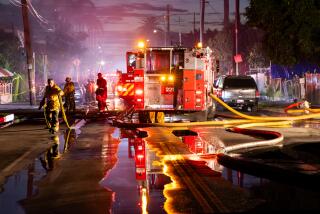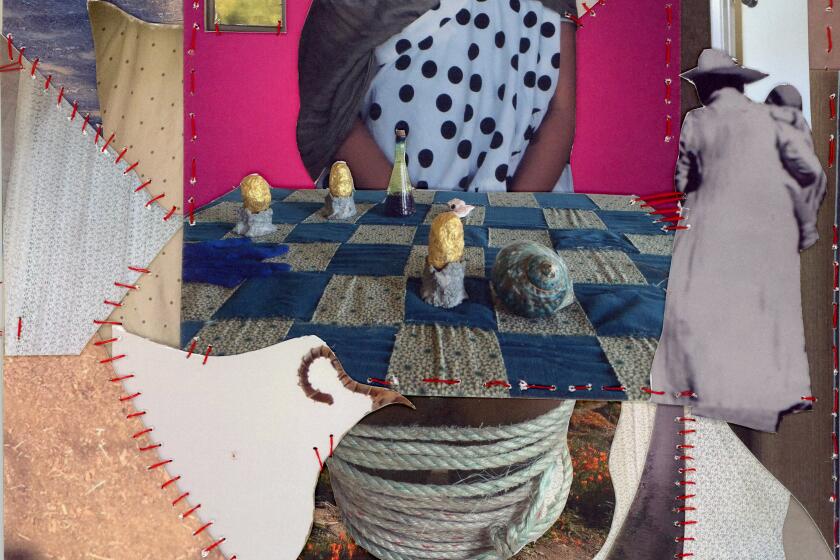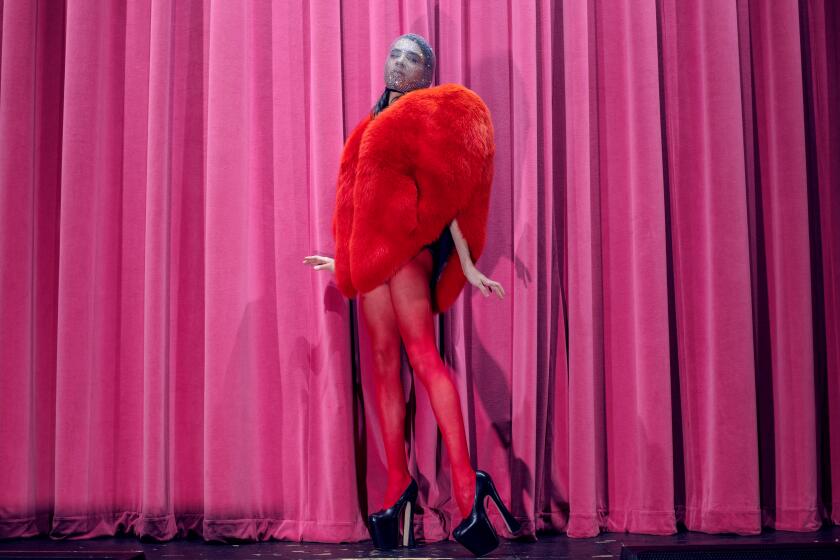A fires survivor

BEFORE James and Anne Hubbell’s home was reborn this year, before it caught fire in 2003, even before its first indoor kitchen was built in the early 1960s, the place looked different from other houses. Like a hobbit’s retreat, perhaps, or an oversized set of shells from some distant sea bottom.
Its materials were raw, its contours irregular and organically curved -- the designer wanted it to look as if it had grown out of the hilltop. But to really understand the place, you had to hear the story.
It went this way: In 1958, James Hubbell, an artist and artisan, and Anne Hubbell, a teacher and musician, decided to build their dream house in the backcountry of San Diego County, beginning with nearly nothing. They were in their 20s and James was working for Sim Bruce Richards, an architect and follower of Frank Lloyd Wright who relied on Hubbell for ironwork, stained-glass windows, mosaic tile works and fanciful sculptures.
The Hubbells decided that they would build their own place the same way, on a 10-acre ridge studded with oak, manzanita and granite boulders, the ground thick with chaparral. For the land they paid $3,500.
They built a room or two at a time, letting the lay of the trees and rocks dictate their plans, adding as new sons arrived and the needs of Hubbell’s art studio arose. Over time the couple also added land, boosting the site to about 45 acres as Hubbell furthered his craft.
“Without the buildings as a way of trying out things,” he says, “I probably wouldn’t have evolved the same way.”
Eventually the household grew to include four sons and a compound of eight buildings, loosely circled like frontier wagons around a hilltop pool. While Hubbell won steadily larger commissions from clients worldwide, his home became an architectural celebrity, cited in the American Institute of Architects’ guide to significant structures in San Diego County.
Then came Chapter Two: a sky filled with smoke and flames.
This was the great Cedar fire of late 2003, which blackened 300,000 acres, destroyed more than 2,200 homes and killed 15 people. The Hubbells, who had been traveling in New York, saw the smoke from their landing plane. In a day and a half as the flames advanced, they grabbed what they could and fled.
The following morning, Hubbell sneaked past barricades and spent 45 minutes at the property, watching his home smolder. Four of the eight structures were gutted. Anne’s harp, which she’d had since age 16, was gone. So were hundreds of heirlooms and artworks, along with tools, furniture and more.
The charred oak skeletons reached up like black, bony fingers. The stained glass had dripped and drooped into tangles worthy of a Dali nightmare. There was no insurance; carriers had told them the location was too vulnerable to fire, the buildings too unusual.
“I’m determined not to let it ruin the rest of my life. I’m not going to give it my misery,” Hubbell told The Times that day. “We have a lot of friends, which is sometimes more important than money. Most times.”
The next day, with firefighting helicopters zooming above and investigators probing the site where firefighter Steven Rucker died in the line of duty -- about 100 yards from the Hubbell property line -- Hubbell returned with his wife and three of their sons.
“The ground was gray, the sky was gray, everything was gray,” remembers Marianne Gerdes, a family friend who joined the Hubbells that morning. “Your feet sunk into the ash because the ground was all burned, a few inches down.” Yet Hubbell, she recalled, was already “pulling out philosophical words” about how the San Diego River would carry the house’s ashes to sea, with transformation to follow.
“We just told each other we weren’t going to be victims,” Hubbell says.
And so to Chapter Three. Within a week, the Hubbells were cleaning up, scheming to get power restored, their well working and the rebuilding underway. Their son Drew, an architect, got the reroofing permits. Mark Tighe, a Ramona builder, artisan and reclaimed-materials specialist who had worked with Hubbell for years, took on the roofs, doors, windows and more, often laboring through winter rain and snow.
“It was a real adventure,” Tighe says. Because so much of the stone, concrete and adobe work had been shaped around a now-absent wooden framework, Tighe had to “build it in reverse,” fitting door frames and windows around the surviving walls and floors.
Though starting over in their 70s was a struggle, both Hubbells agree, it made them appreciate the energy and generosity of family, friends and community; it made them resolve to refine and streamline their living space. It also prompted them to ready the property so that it could serve as a cultural and educational venue when they’re gone.
The fire, they say, has bonded the home to the landscape like never before. Until the fire, “I had never known the land, the mounds, the valleys, the fascinating boulders and texture of the earth, as it was so covered with chaparral,” Hubbell wrote in his 2004 account of the fire. “It is like living with someone for forty years who finally took their clothes off.”
As Hubbell describes the construction and reconstruction of his home, he pads from building to building, points up to a new clerestory window that brightens his first studio, reaches into a cardboard box to pull out a melted bit of stained glass.
The rural household’s integration with the natural world is pungently clear: a distressed skunk had just let loose its scent nearby. A vulture, perhaps drawn by the skunk’s discharge, swoops low to scan for lunch options.
Meanwhile, the chaparral and trees are creeping back, along with some surprises. Though they hadn’t seen quail or roadrunners for years before the fire, Anne says, they now turn up regularly, and she savors the sound of the quail calling, “Chicago, Chicago, Chicago.”
THE first step in recovering from the fire, Hubbell knew, would be putting the studio operation back together. A team of five or six employees usually worked three days a week on the property.
They reconvened in a large and largely undamaged structure known as the drafting room, dividing their efforts between reconstruction and commission work for clients such as the Port of San Diego, the city of Coronado and the Julian public library. With family, friends, other volunteers and contractors joining in the scene, the property’s daily working population swelled to 10 or more, and the Hubbells had decisions to make quickly. What to do the same? What to do differently?
The answers arose the same way the original construction did, building by building.
The first time around, in the late ‘50s, Hubbell began with a building the family calls Jim’s Studio, a concoction of granite, adobe bricks and cedar. Over four years, the family grew to five, all living in that 25-by-30-foot structure. Their kitchen was on a closed-in porch, sometimes requiring Anne Hubbell to wear a winter coat while she cooked and washed dishes.
In 1962, the Hubbells added the roughly 1,100-square-foot main house, an L-shaped combination of kitchen, dining and living rooms with walls of rock and adobe block and a three-sided, indoor-outdoor granite fireplace. A new master bedroom arose soon after that as a free-standing building a few steps away, with walls of adobe and steel-reinforced concrete under a glazed tile roof.
The next addition, around 1970, was the egg-shaped, mosaic-bottomed pool on the property’s highest ground, followed by a 650-square-foot room for the boys that emerged as an emblem of Hubbell’s more playful style.
He calls the boys’ room a “habitable sculpture.” Dug into a hillside, the space is lighted through round, stained-glass windows and sheltered by curving walls and a sprayed-concrete roof that begs to be climbed. It features two lower sleeping areas, a bathroom, a twisting staircase to a sleeping loft, a kitchenette in a closet and a bevy of playful clay figures encrusted on its exterior. In the shower walls he embedded abalone shells, and on the floor he mingled clay tiles and mosaic tile representations of a firebird, a bluebird, a redbird and a peacock.
“It’s like the whole thing is moving around you,” Hubbell says. “This is the most playful part of the houses. It was a chance to do things that didn’t make sense.”
The first studio, the main house, the master bedroom -- all were gutted in the fire, leaving only stone, iron, concrete and charred adobe walls that would have to be chipped away and replastered. But the boys’ room survived with only one significant loss: the stained-glass bathroom skylight, which crashed to the floor.
After weeks of living with family and friends nearby, the Hubbells spent the next three years using the boys’ room as their new home base. In 46 years, Anne Hubbell found, she had advanced from cooking outside to cooking in a closet.
Elsewhere on the property, most of James Hubbell’s studio and gallery space escaped damage, but the largest studio building was a near-total loss. Fueled by paint cans, art materials and a 3-inch-thick wood floor, the flames billowed more than 100 feet into the sky. About $40,000 worth of colored glass, most of it imported from France, fused, warped and shattered inside along with most of Hubbell’s tools. Other casualties included three sheds that held hundreds of artworks.
IN the reconstruction, Hubbell chose not to change the footprint of the buildings. But he did want more light to reach into the original studio, “to be anchored to the ground, but open to the universe.” So he and Tighe raised the roof 2 1/2 feet and added clerestory windows.
For almost all of the reconstruction wood, Hubbell used reclaimed cedar, freshly milled from local fire-damaged trees. In the bathroom, Hubbell and his helpers made a mosaic of Anne’s mother’s china, which had broken in the fire. Spotting the old wrought-iron door hinges in the ruins of the gutted buildings, Tighe and company sandblasted them, powder-coated them and put them back to use.
In the main house, the Hubbells added a few square feet of counter space by the stove, and brought in more green and blue tiles than had been available the first time around, when brown predominated. They also relocated the dishwasher and, at the Hubbell sons’ insistence, added the first clothes-dryer Anne Hubbell had owned in five decades.
“Even in snow, she’ll go out and hang up clothes,” Drew Hubbell says with a sigh. “She’s just used to doing it. She hates to use energy. I don’t even know if she’s used that dryer yet.”
In the dining room, they rehung a Japanese painting of an old man -- inherited from James Hubbell’s mother -- that somehow had survived. The stone fireplace also remains, its browns and reds tending toward gray and black.
In the living room they widened a window-seat bench to make sitting more comfortable and replaced lost furniture with a sofa and chair by San Diego County furniture maker Del Cover and a mesquite table by Mike Creely. In the corner where her harp stood, Anne has substituted a less-costly Roland electric piano; she is taking keyboard lessons for the first time in years.
The living-room floor is made of more reclaimed cedar. Look closely at the long planks and you’ll see that their widths vary, the result of cutting a tapered tree trunk the long way. To even out the dimensions, Tighe alternated narrow and wide plank ends.
In its rebirth, the home has gained fire resistance and energy efficiency. Beneath its floors lies a gas-fired water-to-air heating system, which is more energy-stingy than the old electric system. Above, the main house and old studio have steel roofs (insulated with 5 inches of foam and 2 inches of wood) instead of the old hot-mopped asphalt top. Tighe also installed roof piping, so that a solar panel system can easily be added later.
Three years into the reconstruction, the Hubbells moved back into their rebuilt bedroom, just in time for Christmas 2006. By that time, the studio and gallery spaces were just about back in shape, and a new Passage Garden had been laid out, with a reclaimed-oak gazebo.
With the fourth anniversary of the fire coming up on Oct. 25, the Hubbells are still looking for insurance. They’ve started paperwork to get the compound designated as a county and state historic site. They’ve laid out nearly a mile of new trails on the property. There are plans for a new building to hold archives. A studio staffer has rehabilitated more than 40 of James Hubbell’s small bronze and iron sculptures that came through the fire. And Hubbell’s watercolors have taken on some new tones.
“I did get really interested in black,” he says. “Gray black. Blue black. Indigo . . . “
The fire “has opened up new dimensions” for Hubbell, says friend Milford Wayne Donaldson, a veteran San Diego architect who is now California’s state historic preservation officer. Donaldson has been visiting the compound since the early 1960s, and after the fire, he flew over the site in his private plane, snapping pictures. The way Hubbell has rebuilt, Donaldson says, “an integrated continuum” is still seen in the evolution of buildings over the years, “so that as a person is going through the site, they can see how this man grew and how he changed.”
The Hubbells call the property Ilan-Lael, Hebrew for “tree that belongs to God.” Most of the compound soon will be controlled by the Hubbell Family Foundation and the Ilan-Lael Foundation, an arts-and-education nonprofit the family started in 1980 with a circle of like-minded friends. In generations to come, the idea is to keep the studios in use, perhaps by artists in residence, and keep the other structures vital with cultural and educational programming that leaves intact the site’s quiet rural atmosphere.
All told, Hubbell says, the rebuilding cost them about $300,000. But that figure, he adds, doesn’t begin to capture the value of the efforts contributed by more than 200 friends, clients, employees, artisans, church groups and organizations, from the Federal Emergency Management Agency to the Tijuana school where Hubbell volunteers. One donor alone paid to replace all of Hubbell’s tools -- a $10,000 gesture. At a June fund-raiser, more than 350 visitors contributed $40 each to see the revived property and help build the foundation’s finances.
“We personally needed this, in the unfolding of the meaning of our lives. It was our next step,” Anne Hubbell says. “The fire gives you a chance to say, ‘Look, I can try to do better.’ ”
James Hubbell adds that the place feels right. “I don’t want to use the word better,” he says, “but it feels like it’s been anointed. It’s been through a baptism. There was a community that build it, and they left a lot of themselves.”
*christopher.reynolds@latimes.com
More to Read
Sign up for our L.A. Times Plants newsletter
At the start of each month, get a roundup of upcoming plant-related activities and events in Southern California, along with links to tips and articles you may have missed.
You may occasionally receive promotional content from the Los Angeles Times.







